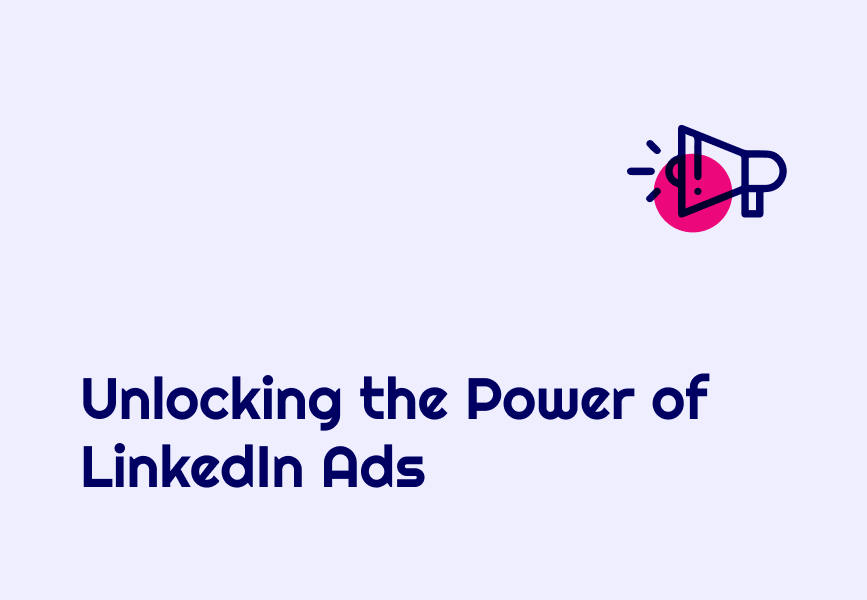Unlocking the Power of LinkedIn Ads
Discover how to maximize the potential of LinkedIn ads to boost your online presence and reach your...

Discover how to maximize the potential of LinkedIn ads to boost your online presence and reach your target audience effectively.
Benefits of LinkedIn Ads
LinkedIn ads offer numerous benefits for businesses looking to expand their online presence and reach their target audience. With LinkedIn's extensive user base of professionals, you can effectively target decision-makers and influencers in your industry.
One of the key benefits of LinkedIn ads is the ability to reach a highly specific audience. You can target your ads based on criteria such as job title, industry, company size, and more. This ensures that your ads are shown to the right people who are most likely to be interested in your products or services.
Another advantage of LinkedIn ads is the platform's robust targeting capabilities. You can narrow down your audience based on factors like location, age, gender, and even interests. This level of precision allows you to tailor your ads to specific segments of your target market, increasing the likelihood of conversion.
LinkedIn ads also provide a range of ad formats to choose from, including sponsored content, text ads, and dynamic ads. This variety allows you to experiment with different formats and find the one that resonates best with your audience.
Furthermore, LinkedIn's ad platform provides detailed analytics and reporting, giving you insights into the performance of your campaigns. You can track metrics such as impressions, clicks, and conversions, allowing you to optimize your ads for better results.
In summary, LinkedIn ads offer businesses a unique opportunity to connect with professionals in their industry and drive targeted traffic to their website. By leveraging the platform's advanced targeting options and diverse ad formats, businesses can unlock the full potential of LinkedIn ads.
Creating a Targeted Campaign Strategy
To make the most of your LinkedIn ads, it's important to develop a targeted campaign strategy. Here are some steps to help you create an effective strategy:
1. Define your goals: Start by identifying what you want to achieve with your LinkedIn ad campaign. Whether it's increasing brand awareness, generating leads, or driving conversions, having clear goals will guide your strategy.
2. Understand your target audience: Research and analyze your target audience to gain insights into their demographics, interests, and pain points. This information will help you create ads that resonate with your audience and drive engagement.
3. Choose the right ad format: Consider the different ad formats available on LinkedIn and select the one that aligns with your campaign goals and audience preferences. Sponsored content is great for promoting blog posts or sharing valuable content, while text ads can be effective for driving website visits.
4. Craft compelling ad copy: Write persuasive and concise ad copy that clearly communicates the value proposition of your product or service. Use compelling visuals and strong call-to-actions to entice users to click on your ads.
5. Set a budget and schedule: Determine your ad budget and set a schedule for your campaign. Monitor your ad performance regularly and make adjustments as needed to optimize your budget allocation.
6. Monitor and optimize: Keep a close eye on the performance of your LinkedIn ads and make data-driven optimizations. Test different variations of your ads, such as headlines, images, and targeting options, to find the winning combination.
By following these steps and continuously refining your campaign strategy, you can maximize the effectiveness of your LinkedIn ads and achieve your marketing objectives.
Optimizing Ad Performance with A/B Testing
A/B testing is a powerful technique that can help you optimize the performance of your LinkedIn ads. By comparing two variations of an ad and measuring their effectiveness, you can identify the elements that resonate best with your audience and improve your ad performance.
Here are some tips for conducting A/B testing on LinkedIn ads:
1. Test one variable at a time: To accurately determine the impact of a specific change, such as headline or image, only test one variable at a time. This will allow you to isolate the effects of each change and make data-driven decisions.
2. Define your success metrics: Before running the A/B test, clearly define the metrics that you will use to measure success. Whether it's click-through rate, conversion rate, or cost per click, having predefined metrics will help you evaluate the performance of each variation.
3. Split your audience evenly: When running A/B tests, it's important to split your audience evenly between the two variations to ensure accurate results. This can be done using LinkedIn's ad platform or with the help of a third-party tool.
4. Run the test for a sufficient duration: Give your A/B test enough time to gather statistically significant data. Running the test for at least a week or until you reach a sufficient sample size will help ensure reliable results.
5. Analyze the results and make data-driven decisions: Once you have collected enough data, analyze the results and compare the performance of each variation. Identify the winning variation and implement the changes in your future ad campaigns.
By regularly conducting A/B tests and optimizing your LinkedIn ads based on the results, you can improve their performance and maximize your return on investment.
Utilizing LinkedIn Ad Formats for Success
LinkedIn offers a variety of ad formats that can help you achieve success with your advertising campaigns. Here are some key ad formats to consider:
1. Sponsored Content: Sponsored content allows you to promote your articles, blog posts, videos, and other valuable content directly in the LinkedIn feed. This format blends seamlessly with organic content, increasing the likelihood of engagement and conversions.
2. Text Ads: Text ads are small, text-based ads that appear on the right side of the LinkedIn desktop interface. They are a cost-effective way to drive website visits and generate leads. Keep the ad copy concise and compelling to capture the attention of your target audience.
3. Dynamic Ads: Dynamic ads are personalized ads that are tailored to each viewer based on their LinkedIn profile information. They can be highly effective in capturing the attention of your audience and driving engagement.
4. Video Ads: Video ads allow you to tell your brand story and engage your audience through video content. With LinkedIn's autoplay feature, your videos can grab the attention of users as they scroll through their feed.
5. Message Ads: Message ads enable you to send personalized messages directly to your target audience's LinkedIn inbox. This format is great for nurturing leads and driving conversions through one-on-one conversations.
When utilizing LinkedIn ad formats, it's important to consider your campaign goals, target audience, and the type of content you want to promote. By choosing the right ad format and tailoring your content to resonate with your audience, you can achieve success with your LinkedIn ads.
Measuring and Analyzing Campaign Results
Measuring and analyzing the results of your LinkedIn ad campaigns is crucial for optimizing their performance and maximizing your return on investment. Here are some key metrics to track and analyze:
1. Impressions: Impressions measure the number of times your ads are shown to LinkedIn users. Monitoring impressions can help you gauge the reach and visibility of your campaigns.
2. Click-through Rate (CTR): CTR measures the percentage of users who clicked on your ad after seeing it. A high CTR indicates that your ad is engaging and resonating with your audience.
3. Conversions: Conversions track the number of users who took a desired action, such as filling out a form or making a purchase, after clicking on your ad. Tracking conversions allows you to assess the effectiveness of your campaigns in driving tangible results.
4. Cost per Click (CPC): CPC measures the average cost you pay for each click on your ad. Monitoring CPC can help you optimize your budget allocation and ensure that you are getting the most value from your ad spend.
5. Engagement: Engagement metrics, such as likes, comments, and shares, indicate how well your ads are resonating with your audience. High engagement levels suggest that your content is valuable and engaging.
6. Return on Investment (ROI): ROI measures the profitability of your LinkedIn ad campaigns by comparing the revenue generated with the cost of running the campaigns. Calculating ROI allows you to assess the overall effectiveness of your advertising efforts.
By regularly monitoring these metrics and analyzing the results, you can identify areas for improvement and make data-driven decisions to optimize your LinkedIn ad campaigns. Experiment with different ad variations, targeting options, and strategies to continuously improve your results.
Your ultimate guide to strategic outsourcing
Subscribe for expert tips, trends, and tailored solutions.



